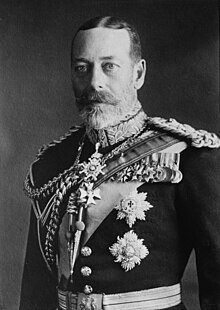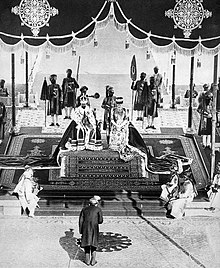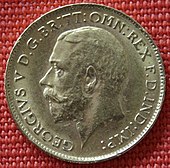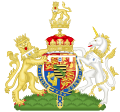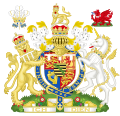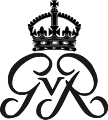George V (United Kingdom)
George V ( English : George V , born HRH Prince George Frederick Ernest Albert of Wales ; born June 3, 1865 in Marlborough House , City of Westminster , London , † January 20, 1936 in Sandringham House , Norfolk ) from the House of Saxony -Coburg and Gotha was King of the United Kingdom of Great Britain and Ireland ( Northern Ireland since 1927 ) and Emperor of India from May 6, 1910 until his death .
Due to domestic political pressure during the First World War , George V changed the Anglicized name of his dynasty Saxe-Coburg and Gotha to the name Windsor, which is still used today .
origin
HRH Prince George of Wales was born on June 3, 1865, the second son of British Crown Prince Albert Eduard, Prince of Wales , and his wife Alexandra of Denmark in Marlborough House . On his father's side Georg was a grandson of Queen Victoria , on his mother's side he came from the Danish King Christian IX. from and was behind his father and older brother Albert Victor in third place in the line of succession to the British throne.
On July 7, 1865, the Archbishop of Canterbury , Charles Longley, named him George Frederick Ernest Albert at Windsor Castle .
Due to the marriage policy of his grandparents, there were close relationships with numerous European ruling families. Georg was a cousin of the Russian Tsar Nicholas II and the German Emperor Wilhelm II , to name the two most important.
Early years
Up to the age of six, nannies and governesses were responsible for the upbringing of George and his brother Albert Victor (called "Eddy"), who was seventeen months older than him. On the instructions of Albert Edward, his five descendants - in addition to the prince, the heir to the throne had three daughters ( Louise , Victoria and Maud ) - enjoyed an informal and liberal upbringing that lacked a great deal of discipline, which is why Queen Victoria often complained about her bad behavior Grandson complained. From 1871 the education was under the responsibility of the Anglican clergyman John Neale Dalton , who was the tutor for the two princes for the next twelve years , but showed himself only to a limited extent for this task. Dalton did not succeed in arousing the interest of the princes in the learning content, which is why the academic performance of Georg and Albert Victor in particular was described as below average.
In September 1877, the princes joined the Royal Navy . As midshipmen on the training ship HMS Britannia in Dartmouth , they received training that was characterized by military drill, strict discipline and a spartan lifestyle. For further training purposes, they then went on a three-year trip around the world (1879–1882), accompanied by Dalton, on board the HMS Bacchante armored corvette . They traveled to the West Indies , Virginia , South America , the Falkland Islands , Australia , Fijis , Japan , Ceylon , the Cape Colony , Aden , Egypt , Palestine and the Mediterranean . In order to improve her poor knowledge of French and German , she returned to Lausanne for six months , which however did not achieve the desired result.
In 1883 the brothers were separated from each other. While Albert Victor attended Trinity College at the University of Cambridge , Georg continued to pursue his officer career in the Royal Navy. After attending the Royal Naval College in Greenwich , he served in the Mediterranean Fleet on Malta from 1886 to 1888 , and in 1889 Georg became the commander of HMS Torpedo Boat no.75. In 1890, he commanded the gunboat HMS Thrush in the North Atlantic ( Atlantic Fleet ) before joining the August 1891 was promoted to Commander and was given command of the protected cruiser HMS Melampus .
The early death of Albert Victor on January 14, 1892 ended the naval career of George, who now became the designated heir to the throne of his father. As an expression of his increased importance to the dynasty, Queen Victoria named her grandson Duke of York on May 24, 1892 . George was given a seat in the House of Lords , an apartment in London's St James's Palace (York House) and the country estate York Cottage on his father's estate in Sandringham . In preparation for his future role, Georg was instructed in constitutional history by the university professor J. R. Tanner , with the work The English Constitution by Walter Bagehot forming the central learning content.
Marriage and offspring
At the request of his grandmother Victoria, Georg married his late brother 's fiancée, Maria von Teck, on July 6, 1893 in the Chapel Royal of St James's Palace . She was the eldest daughter of the German-born Duke Franz von Teck and his wife Mary Adelaide of Cambridge . Both bride and groom were due to their descent from George III. 2nd degree aunt and nephew, and although the marriage was arranged, a bond of love developed between them. Maria (“May”) always supported her husband loyally, Georg remained loyal to her all his life.
Six offspring resulted from the connection:
- Edward , Prince of Wales (23 June 1894 - 28 May 1972), King Edward VIII in 1936, after his abdication Duke of Windsor ⚭ Wallis Simpson
- Albert , Duke of York (born December 14, 1895 - † February 6, 1952), as George VI. from 1936 to 1952 King ⚭ Elizabeth Bowes-Lyon
- Mary , Princess Royal (April 25, 1897 - March 28, 1965) ⚭ Henry Lascelles , 6th Earl of Harewood
- Henry , Duke of Gloucester (March 31, 1900 - June 10, 1974) ⚭ Alice Montagu-Douglas-Scott
- George , Duke of Kent (* December 20, 1902 - † August 25, 1942) ⚭ Marina of Greece and Denmark
- Prince John (July 12, 1905 - January 18, 1919)
Georg maintained a distant, unemotional relationship with his children and was a strict, pedantic father to them. He treated his sons like sea cadets and demanded the highest level of discipline from them, which in some cases had a negative effect on their development. To his confidante Lord Stanley he confessed: "My father was afraid of his mother, I was afraid of my father and I damn well want to see that my children are afraid of me" ("My father was frightened of his mother, I was frightened of my father, and I am damned well going to see to it that my children are frightened of me. ").
Life until 1910
Due to his quiet, withdrawn, sometimes bourgeois family life at the side of his wife, the dutiful, scandal-free Georg differed significantly from his fun-loving father, whose household was the social center of the British upper class. In addition to his official duties for the Crown, Georg preferred the simple life at his country estate York Cottage in order to devote himself extensively to his passions of stamp collecting , hunting and sailing .
With the death of Victoria on January 22nd, 1901, his father ascended the British throne as Edward VII. As direct heir to the throne, George inherited the title of Duke of Cornwall and the residence of Marlborough House . With Sir Arthur Bigge , who had already served his grandmother in a similar capacity (Private Secretary to the Sovereign), Georg received a private secretary who held this influential position until 1931. On behalf of the government, the new Crown Prince couple embarked on an eight-month voyage through the British Empire on board the specially rented steamship Ophir . The journey took them via Gibraltar , Malta , Port Said , Aden , Ceylon , Mauritius and Singapore to Australia , New Zealand , Canada , Newfoundland and the Cape Colony . Georg and Maria accepted congratulations for the new king and thanked the Dominions for their support during the Second Boer War (1899–1902). In Melbourne , Australia , Georg opened the first parliamentary session of the newly created Commonwealth of Australia on May 9, 1901 .
After his return, his father gave him the traditional title of heir to the throne by making Georg Prince of Wales on November 9, 1901 . Edward VII was willing to prepare his son for his future role as king better than he had been prepared himself, which is why Georg was given extensive access to cabinet papers and other state documents. Between 1905 and 1907 Georg held the oldest military office in the monarchy as Lord Warden of the Cinque Ports and supported the naval reforms of the First Sea Lord , Admiral John Fisher .
On an eight-month tour through British India between October 1905 and May 1906, Georg gained a deeper insight into the prevailing living conditions on the subcontinent .
In 1906 the Prince and Princess of Wales attended the wedding of George's cousin Victoria Eugénie von Battenberg with the Spanish King Alfonso XIII. as well as the coronation celebrations of his sister Maud and her husband Haakon VII in Norway .
As a king
With the death of Edward VII on May 6, 1910, Georg inherited the royal dignity. The following day he was formally proclaimed George V in St James's Palace in front of the Accession Council and swore the monarchical oath of allegiance . The traditional coronation ceremony was held at Westminster Abbey on June 22, 1911 , George was anointed and solemnly crowned with the Crown of Edward by the Archbishop of Canterbury, Randall Thomas Davidson . On the occasion of the coronation, the Festival of Empire, a forerunner of the Commonwealth Games , was held in London's Crystal Palace , and the Royal Navy held a fleet review in front of Spithead ( Coronation Fleet Review on June 24, 1911).
As the first crowned monarch, Georg traveled to British India with Maria to personally attend the Delhi Durbar (Court Day in Delhi). Culmination of several days of festivities was the official proclamation of the Emperor of India (Emperor of India) on 12 December 1911, Coronation Park. Wearing the newly designed Imperial Crown of India , Georg received the homage of thousands of Indian princes and dignitaries in a ceremony lasting several hours. In a statement, Georg announced the relocation of the capital from Calcutta to (New) Delhi and then laid the foundation stone.
The first months of George V's reign were marked by the constitutional conflict that had been smoldering since 1909 between the conservatively dominated House of Lords and the liberal House of Commons . Georg initially hesitated to change the majority structure in the House of Lords by appointing liberal lords ("peer boost"). In his new role, George did not want to carry out such a drastic attack on the rights of the nobility with one of his first acts and had to be gradually persuaded by the liberal Prime Minister H. H. Asquith to accept this. He also received conflicting advice from his two secretaries, Francis Knollys and Arthur Bigge . The former tended towards the Liberals, the latter encouraged George to deny Asquith the guarantees he demanded. However, before the general election in December 1910 , King Asquith finally gave his pledge, after which Asquith's government was able to restrict the power of the House of Lords with the Parliament Act of 1911. This shift in legislative power in favor of the House of Commons was particularly important in resolving the question of Irish self-government ( Home Rule ).
First World War
In the course of the July crisis in 1914, the British government tried to act as a mediator and diplomatically settle the tensions. However, the proposal to host a conference of European foreign ministers in London was not well received. In view of the German intentions to mobilize against Russia and the resulting alliance for the Triple Entente , which would inevitably lead to the outbreak of a European war, George V offered his mediation in a telegram to Paris and Saint Petersburg on July 31, 1914 in vain: “Um to eliminate the misunderstanding ”that he felt must have arisen and“ to leave room for negotiations and peace opportunities. ”After the German Reich violated Belgian sovereignty , Great Britain declared war on August 4, 1914, and George V signed it in the morning the declaration of war on his cousin Wilhelm II. As king, Georg was nominal commander-in-chief of the British armed forces , but at no time did he actively influence the war. His role was limited to purely representative tasks. He awarded a total of around 50,000 medals and awards, showed tireless efforts when visiting armaments factories, military hospitals , hospitals and survivors, and visited the frontline area and naval bases several times. To thank his compatriots for their commitment during the war, Georg endowed an Order of Merit with the Order of the British Empire on June 4, 1917 . During a visit to the front in Flanders on October 28, 1915, he fell from his horse and suffered a painful hip fracture that affected him for life.
At the height of the Battle of the Somme in August 1916, the monarch was present for several days at the French headquarters in Château Val Vion to exchange ideas with French President Raymond Poincaré , General Joseph Joffre and General Douglas Haig .

The outbreak of World War I was accompanied by a wave of massive anti-German sentiment, as the British public saw the German Reich as the main opponent of the war. At the center of the hostility was a cousin of George V, Ludwig von Battenberg , who was urged to resign as First Sea Lord on October 27, 1914 because of his German origins . As the war went on, anti-German tendencies increased, and even if the king described himself as completely British, the resentment also hit the royal family. When Prime Minister David Lloyd George was once appointed to Georg, he is said to have remarked: “I would like to know what my little German friend has to say to me.” The writer HG Wells insinuated in a newspaper article that this “had no inspirational effect ”And he was“ foreign ”. In view of the sustained domestic political pressure and against the background of the Russian February Revolution , George V finally felt compelled to take a spectacular step. Determined to redefine the royal family as a British institution, on July 17, 1917, he proclaimed the renaming of his German-sounding house Saxe-Coburg and Gotha to Windsor , named after Windsor Castle , which has symbolized the British monarchy for 800 years. Georg renounced all German naming rights and titles for himself and all of Queen Victoria's descendants. Demonstratively, he had the German banners removed from St George's Chapel at Windsor Castle, and with this patriotic act he made his popularity much more popular. Following his example, Georg's cousin changed the German name Battenberg to the Anglicized form Mountbatten and received the title of Marquess of Milford Haven from the king . He also conferred British nobility titles on his wife's German relatives from the Teck family .
After the Tsar's abdication (March 15, 1917) during the February Revolution of 1917 , the British government offered Nicholas II and his family political asylum. Fearing that the presence of the tsar, who was hated by the British population, could encourage the outbreak of a revolution in Great Britain too, Georg persuaded the government to withdraw the offer. The Tsar, after all a cousin of George, and his family stayed in Russia and were murdered by the Bolsheviks in July 1918 .
On the day of the armistice (November 11, 1918), George and Mary were cheered by an enthusiastic crowd on the balcony of Buckingham Palace .
Later years in government
The political upheavals of World War I had toppled the monarchies in Russia , the German Empire , Austria-Hungary , Greece and the Ottoman Empire , whereas the British monarchy had proven to be stable. Nevertheless, George V expressed concern about the rise of socialism in Europe, which made him aware of the concerns of the growing labor movement . Mindful of his essence, he dutifully accepted his role as constitutional monarch when he named Ramsay MacDonald for the first time on January 22, 1924, a Labor Party politician as prime minister. George was a model of discipline and morality, and his tactful understanding brought the monarchy closer together with the ruling party, which enabled him to maintain his reputation among the population. During the Great Depression at the beginning of the 1930s, Georg expressly advocated the creation of a National Government . During the political and economic crisis, the king held talks with the conservative and liberal party leaders in order to form a government made up of "men of all parties", which ultimately led to the creation of a cabinet made up of members of the three major parties under Ramsay MacDonald in 1931. To relieve the state budget, Georg granted the government a reduction in financial expenses for the royal family.
Under the reign of George V, the British Empire reached its greatest expansion in 1922. It extended over an area of about 33.67 million square kilometers, which corresponds to a quarter of the land area of the earth, and with 458 million inhabitants comprised a quarter of the world population at that time. In his domain, Britain had to deal with a number of conflicts, such as the Indian independence movement ( Amritsar Massacre ) or the Irish War of Independence (1919-1921), who as a result of the Anglo-Irish Treaty, the division of the island and renamed United Kingdom of Great Britain and Northern Ireland followed. The new world order resulting from the First World War required a fundamental reorientation of British foreign policy and a reorganization of relations within the Empire. At the Imperial Conference opened by George V in 1926 , the Dominions ( Canada , Newfoundland , Australia , New Zealand , South African Union and Irish Free State ) were given equal status with Great Britain according to the Balfour Declaration , which was a decisive step in the transformation of the Empire into the Commonwealth of Nations was. The Westminster Statute (1931) made these Commonwealth Realms self-governing autonomous communities and granted them legislative independence.
Although he was always reluctant to take on technical innovations, George V established a tradition by broadcasting his Christmas address on the radio , which is still going on today. The King's Christmas Message was broadcast on Christmas Day 1932 in the countries of the Commonwealth of Nations via the British Broadcasting Corporation Empire Service (now BBC World Service ) .
Georg's relationship with his eldest son, Prince Edward, was considered shattered at the beginning of the 1930s. In particular , he strictly rejected the relationship between the heir to the throne and the divorced American Wallis Simpson . The king never received Mrs. Simpson personally and made his wife swear not to do so after his death. He said of his son: "If I am dead, the boy will be ruined within twelve months." ("After I am dead, the boy will ruin himself in twelve months."), He was right.
The 25th anniversary of the throne of George V (Royal Silver Jubilee) on May 6, 1935 was celebrated by the British public as a national holiday. In addition to numerous ceremonies, such as a service in St Paul's Cathedral and Westminster Hall , George and Mary paraded through London in an open carriage. The couple was greeted enthusiastically by the population and the popularity of the "Sailor King", as Georg was called due to his naval career, reached its peak. For five consecutive days, the royal couple appeared on the balcony of Buckingham Palace to a crowd.
End of life
In addition to hip problems since falling from a horse, Georg suffered from chronic respiratory and breast diseases ( pleurisy and a chronic obstructive pulmonary disease ) since the mid-1920s ; nevertheless he remained a chain smoker . His health deteriorated significantly due to an infectious poisoning of the right lung, which was diagnosed in November 1928 and had to be treated surgically (the advice of the German surgeon Ferdinand Sauerbruch , who is known in the field of thoracic surgery, was also sought). During a three-month spa stay in the southern English seaside resort of Bognor, Georg slowly recovered. During this time he was represented by his son and heir to the throne, later Edward VIII. The public concern for the monarch's health was great at that time.
From the spring of 1935, Georg suffered from a general deterioration in his bronchial system . He could no longer get out of bed from mid-January 1936 and died on January 20, 1936 at his country estate at Sandringham House. After transfer to London's four-day lying in state followed in Westminster Hall before his coffin on January 28 on a gun carriage for under large sympathy of the population Paddington Station was taken and by train to Windsor Castle. The carriage was followed by his four sons, led by Edward VIII, as well as Christian X. of Denmark , Haakon VII. Of Norway , Leopold III. of Belgium , Boris III. of Bulgaria and Carol II of Romania . He was buried in St George's Chapel in Windsor.
Georg's personal physician , Lord Dawson , wrote in his diary published in 1986 that he had accelerated the inevitable death of his patient by a few hours through active euthanasia by injecting a mixture of cocaine and morphine into his carotid artery. He wanted to protect the dignity of the monarch in his phase of agony by saving him a long agony in front of the eyes of those present in the dying room. He also wanted to ensure that death occurred early enough to be announced in the morning edition of the Times (which he considered the most important and worthy newspaper in the country). If he had died later, the public would have learned of his death through the evening tabloids.
In the course of 1936 the crisis of abdication eased. Edward VIII. Abdicated on Dec. 11, 1936 in favor of his younger brother Albert, Duke of York from and plunged the British monarchy into a crisis (see main article → abdication of Edward VIII. ) .
personality
The king was only moderately educated, poorly read and hardly interested in the fine arts and sciences. Unlike his father, he surrounded himself almost exclusively with a circle of friends from the old landed aristocracy, avoided London and the social environment there as much as possible and instead cultivated friendly relationships with Lord Curzon , Lord Derby , the Duke of Devonshire and the Duke of Richmond . He was critical of the increasing inflation of appointments to the nobility. He complained several times that David Lloyd George ignored the royal prerogatives during his time as Prime Minister and distributed peerages without informing him at all. He spent a large part of his free time as an avid stamp collector ( philatelist ). He built up the stamp collection of the British royal family, the Royal Philatelic Collection . Today it is one of the largest and most valuable in the world and became state property after Georg's death. He bought rarities from philately all over the world. At the auction of the world's rarest postage stamp, the British Guiana 1 ¢ magenta , it was outbid by Arthur Hind . This auction took place in the course of the dissolution of the Ferrary collection . His great enthusiasm for philately also ensured that the hobby spread in Great Britain.
His special passion was sailing. With the regatta yacht HMY Britannia , which he inherited from his father, King Edward VII, he took part very successfully in many regattas, especially during Cowes Week . On his deathbed he decreed that his beloved yacht should follow him into death. As requested, she was sunk off the Isle of Wight by a Royal Navy warship .
Coat of arms and title
George, Duke of York
George, Prince of Wales
- June 3, 1865 to May 24, 1892: His Royal Highness Prince George of Wales
- May 24, 1892 to January 22, 1901: His Royal Highness The Duke of York, Earl of Inverness, Baron Killarney
- January 22 to November 9, 1901: His Royal Highness The Duke of Cornwall and York, Duke of Rothesay
- November 9, 1901 to May 6, 1910: His Royal Highness The Prince of Wales, Earl of Chester
- May 6, 1910 to April 12, 1927: His Majesty George V, by the Grace of God, of the United Kingdom of Great Britain and Ireland and of the British Dominions beyond the Seas, King, Defender of the Faith, Emperor of India
- April 12, 1927 to January 20, 1936: His Majesty George V, by the Grace of God, of Great Britain, Ireland and the British Dominions beyond the Seas, King, Defender of the Faith, Emperor of India
Pedigree
See also
literature
- Tom Levine: The Windsors: The Glory and the Tragedy of an Almost Normal Family . Bastei Lübbe, Bergisch Gladbach 2007, ISBN 978-3-404-61619-0 .
- Helmut-Maria Glogger : The Secret Life of the Windsors: The Whole Truth . Knaur, Munich 2006, ISBN 978-3-426-77951-4 .
- Kenneth Rose: King George V. Weidenfeld and Nicolson, London 1983, ISBN 0-297-78245-2 .
- Miranda Carter: The Three Emperors: Three Cousins, Three Empires and the Road to World War One , Penguin, London 2010, ISBN 978-0141019987
- Catrine Cley: King, Kaiser, Tsar: Three Royal Cousins Who Led the World to War , London 2006, John Murray, ISBN 978-0-7195-6537-3
- David Cannadine : George V - The unexpected King , London 2014, Penguin Random House UK, ISBN 978-0-141-97690-7
Web links
- Literature about George V in the catalog of the German National Library
- http://www.oxforddnb.com/view/article/33369
- http://www1.wdr.de/radio/wdr5/sendung/zeitzeichen/georg104.html
- Newspaper article about George V in the 20th century press kit of the ZBW - Leibniz Information Center for Economics .
Individual evidence
- ↑ Wilfried Burkard, Leo Hepner, Manfred Jehle, Georg Paulus, Andrea Weindl: The great dynasties. Lingen-Verlag, Cologne 2012, DNB 1029882398
- ↑ Various sources according to Google book search
- ↑ Roy Jenkins: Mr. Balfour's Poodle. Bloomsbury Reader, London 2012, pp. 142 ff.
- ↑ Janusz Piekałkiewicz : The First World War , Weltbild, 1989, ISBN 3-89350-564-4
- ^ Catrine Clay (2007): King, Kaiser, Tsar: Three Royal Cousins Who Led the World to War. Walker Books, ISBN 978-0802716231 , pp. 339-441.
- ^ Ferguson: Colossus. P. 15.
- ^ Angus Maddison: The World Economy: A Millennial Perspective . Ed .: OECD . 2001, ISBN 92-64-18654-9 , pp. 98, 242 .
- ↑ Philip Ziegler: King Edward VIII: A Life. Random House, 1992, p. 174.
- ↑ Ferdinand Sauerbruch, Hans Rudolf Berndorff : That was my life. Kindler & Schiermeyer, Bad Wörishofen 1951; cited: Licensed edition for Bertelsmann Lesering, Gütersloh 1956, pp. 352 f. and 356–358.
- ^ Special edition of The Illustrated London News, January 25, 1936, on the occasion of the death of George V.
- ↑ JOSEPH LELYVELD: 1936 SECRET IS OUT: DOCTOR SPED GEORGE V'S DEATH. New York Times, November 28, 1986.
- ^ David Cannadine: The Decline and Fall of the British Aristocracy. Vintage Books, London 1999, p. 353.
- ^ David Cannadine: The Decline and Fall of the British Aristocracy. Yale University Press, New Haven CT et al. 1990, pp. 317 f.
- ↑ Portrait: Yacht Britannia ( Memento of the original from August 28, 2008 in the Internet Archive ) Info: The archive link was inserted automatically and has not yet been checked. Please check the original and archive link according to the instructions and then remove this notice. Retrieved January 18, 2009
| predecessor | Office | successor |
|---|---|---|
| New title created |
Duke of York 1892-1910 |
Title merged with the crown |
| Edward VII |
Prince of Wales Duke of Cornwall Duke of Rothesay 1901-1910 |
Edward of Wales, later King Edward VIII. |
| Edward VII |
King of the United Kingdom, Emperor of India 1910–1936 |
Edward VIII |
| personal data | |
|---|---|
| SURNAME | George V. |
| ALTERNATIVE NAMES | George Frederick Ernest Albert of Saxe-Coburg and Gotha |
| SHORT DESCRIPTION | British King (1910-1936) |
| DATE OF BIRTH | June 3, 1865 |
| PLACE OF BIRTH | London |
| DATE OF DEATH | January 20, 1936 |
| PLACE OF DEATH | Sandringham House |
